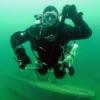
Tech Diving Equipment
#1

Posted 03 March 2006 - 08:29 AM
Can anyone give me a break down of what basic equipment will be needed. I know there is special equipment needed for things like cave diving and so on, I am just looking for a basic break down.
I also realize that everything has redundancy. The main thing I am interested in is how to set up to run doubles.
Any information that can be provided for me on this will be greatly appreciated.
#2

Posted 03 March 2006 - 10:51 AM
BP/W is really not "technical" per se. Just a modular BC. But it's used in tech diving because it's simple and allows for infinte adjustments. It's also very secure.
If you want to dive doubles, leave the TUSA at home and get a BP/W. You might find you like it for ALL your diving, just like so many other people have.
Not all tech gear is redundant. You'll find that people tend to carry LESS stuff than a lot of recreational divers. The mantra is to take only what you need, and nothing more. However, you also have to realize that the idea of "coming to the surface" to handle problems is not in the equation, so you'll have to have gear that allows this.
To me, so called techincal diving is more about a mindset than a set of gear.
I'll let the others get into the specifics on fins, regs, tanks, computers, etc. I'm pretty new to a lot of this as well, and woudln't want to pollute the waters...
-P
#3

Posted 03 March 2006 - 11:56 AM
As one person here used to say, the term "tech" diving itself is a misnomer. All that it consists is a little different mindset and leaving the mindset of "I can end the dive and go to the surface if I have a problem." This mindset is replaced with "underwater problems have to be fixed underwater."
Keeping that in mind, you will start looking at thermal protection for decompression hangs (one can't think well when they are cold) and simplifying your rig to only take down what you need. More gear than you need can become failure points.
Even if you think that your OW instructor taught you to streamline your rig, you will find the first day of a "tech" course to be like boot camp where your gear gets torn apart and rebuilt before your eyes. You will learn to hate even mild "danglies". We had an instructor in NC who was running cave line over people's rigs. The reason was to demonstrate where one little catch point can catch on a wire or fishing line.
Most divers of this nature use a canister light instead of the "flashlight" or "spotlight" that you see used by the "recreational" divers. Why? Because the "other kind" tend to hang out from your body when clipped off where as the canister, cord and light head are readily available and stay next to your body.
Let's see... Many "techies" use spring straps on their fins instead of the rubber straps and buckles. They are simple, tend to be bulletproof and eliminate fin buckles as a catch point.
But as far as gear considerations, they are small in my mind as compared to mindset issues. If you get the mindset right, then the rig will be a continuing evolution and you will find the right gear to do what you wish to do.
#4

Posted 03 March 2006 - 12:08 PM
"For the diligent diver, closed circuit rebreathers are actually safer than open circuit scuba." Tom Mount
#5

Posted 03 March 2006 - 12:19 PM
And I third that. I waited to purchase gear until I was actually in non-recreational/technical dive training*. One of my regular dive buddies did not and had purchased a lot of gear he thought was appropriate. He has since sold all of that off and now has a set that...oddly...is close to identical to mine...hmmmmI would suggest that you look for an instructor, and then talk to the instructor about what to get before buying anything. As Brian mentions, the first class usually consists of gear and its configuration so that students have time to get what they need before doing the first dives.
My instructor went through every piece of equipment and explained the different choices available and most importantly the WHY behind gear choices. I am so pleased with my gear purchases and configuration and I can explain every one of them to anyone who asks. My training was worth every penny (Extreme Underwater).
* Call is whatever you want. Arguing about a name for it just becomes silly at some point. Basically this kind of diving involves a whole lot more gear, diver can go deeper than 130', stay longer, and commit themselves to the water unlike in recreational diving – and it’s become more common to hear the term “technical diving” to describe it.
Once in a while, it is good to step back, take a breath, and remember to be humble. You'll never know it all - ScubaDadMiami. If you aren't afraid of dying, there is nothing you can't achieve - Lao-tzu. One dog barks at something, the rest bark at him - Chinese Proverb.
#6

Posted 03 March 2006 - 12:24 PM
#7

Posted 03 March 2006 - 12:37 PM
There is a mindset (and gear config) out there called Hogarthian. It's namesake, Bill Hogarth Main, was a cave diver who essentially put forth this mantra of take only what you need, streamlining gear, he is the inventor of the backplate/wing system, etc.
Recently, a group of divers known as DIR divers, has codified this idealogy and come up with a fairly complete gear configuration that seems to work nicely for most technical diving. I would consider it safe to use as a "shopping list" if you'd like to begin purchasing some tech gear. There is a book published by one member of this group called "Dress for Success, by Dan Mackay. It focuses solely on the gear configuration as can be used as a blueprint for dressing yourself for technical diving. While I had access to a wide variety of information, instructors, and technical divers while buying my gear, this book pulled everything together nicely for me. You might also find it helpful.
Best of luck in your quest. And I hope I haven't offended anyone here by referring to the GUE/DIR stuff.
-P
#8

Posted 03 March 2006 - 12:41 PM
Once in a while, it is good to step back, take a breath, and remember to be humble. You'll never know it all - ScubaDadMiami. If you aren't afraid of dying, there is nothing you can't achieve - Lao-tzu. One dog barks at something, the rest bark at him - Chinese Proverb.
#9

Posted 03 March 2006 - 12:53 PM
Nevermind, found it on a goggle search
Edited by Vessper, 03 March 2006 - 12:55 PM.
#10

Posted 03 March 2006 - 05:31 PM
#11

Posted 03 March 2006 - 06:15 PM
And I third that. I waited to purchase gear until I was actually in non-recreational/technical dive training*. One of my regular dive buddies did not and had purchased a lot of gear he thought was appropriate. He has since sold all of that off and now has a set that...oddly...is close to identical to mine...hmmmmI would suggest that you look for an instructor, and then talk to the instructor about what to get before buying anything. As Brian mentions, the first class usually consists of gear and its configuration so that students have time to get what they need before doing the first dives.

My instructor went through every piece of equipment and explained the different choices available and most importantly the WHY behind gear choices. I am so pleased with my gear purchases and configuration and I can explain every one of them to anyone who asks. My training was worth every penny (Extreme Underwater).
I'll 4th that along with interview your instuctor,try and talk to some of his students.All courses should provide an equitment list that you can get even before signing up for anything.Compare and you'll see there are many similar things on all list so start there.
There is a book published by one member of this group called "Dress for Success, by Dan Mackay. It focuses solely on the gear configuration as can be used as a blueprint for dressing yourself for technical diving. While I had access to a wide variety of information, instructors, and technical divers while buying my gear, this book pulled everything together nicely for me. You might also find it helpful.
Best of luck in your quest. And I hope I haven't offended anyone here by referring to the GUE/DIR stuff.
-P
Another book(along with Dan's which also has losts of good info for the non tech ie drysuit info) is Doing it Right-The fundementals of better diving by Jarrod Jablonski.
Both theses books along with others containe usefull info..
Get as much info as possibe and get differnent view point and then decide for youself 'cause as otheres have said it about a mindset and being a thinking diver is the most important mindset.Knowing why you do something is what allows you to think a problem through because all the training in the world wont cover every possible combination that can and will occur.
Eric
#12

Posted 04 March 2006 - 02:26 PM
. . . Hogarth . . . is the inventor of the backplate/wing system, etc.
While Hogarth certainly get credit for the concept, I don't believe he was the inventor of the backplate. I don't think he invented the wing either. I am not sure if he was among the first to put them together or not. Can you tell me where you got the information? Maybe it's so.
"For the diligent diver, closed circuit rebreathers are actually safer than open circuit scuba." Tom Mount
#13

Posted 04 March 2006 - 03:52 PM
Quick search results - refuting Hogarth as the originator -. . . Hogarth . . . is the inventor of the backplate/wing system, etc.
While Hogarth certainly get credit for the concept, I don't believe he was the inventor of the backplate. I don't think he invented the wing either. I am not sure if he was among the first to put them together or not. Can you tell me where you got the information? Maybe it's so.
http://www.dive-rite...s/backplate.htm
Jacques Yves Cousteau
#14

Posted 05 March 2006 - 12:41 PM
And I third that. I waited to purchase gear until I was actually in non-recreational/technical dive training*. One of my regular dive buddies did not and had purchased a lot of gear he thought was appropriate. He has since sold all of that off and now has a set that...oddly...is close to identical to mine...hmmmmI would suggest that you look for an instructor, and then talk to the instructor about what to get before buying anything. As Brian mentions, the first class usually consists of gear and its configuration so that students have time to get what they need before doing the first dives.

My instructor went through every piece of equipment and explained the different choices available and most importantly the WHY behind gear choices. I am so pleased with my gear purchases and configuration and I can explain every one of them to anyone who asks. My training was worth every penny (Extreme Underwater).
I'll 4th that along with interview your instuctor,try and talk to some of his students.All courses should provide an equitment list that you can get even before signing up for anything.Compare and you'll see there are many similar things on all list so start there.There is a book published by one member of this group called "Dress for Success, by Dan Mackay. It focuses solely on the gear configuration as can be used as a blueprint for dressing yourself for technical diving. While I had access to a wide variety of information, instructors, and technical divers while buying my gear, this book pulled everything together nicely for me. You might also find it helpful.
Best of luck in your quest. And I hope I haven't offended anyone here by referring to the GUE/DIR stuff.
-P
Another book(along with Dan's which also has losts of good info for the non tech ie drysuit info) is Doing it Right-The fundementals of better diving by Jarrod Jablonski.
Both theses books along with others containe usefull info..
Get as much info as possibe and get differnent view point and then decide for youself 'cause as otheres have said it about a mindset and being a thinking diver is the most important mindset.Knowing why you do something is what allows you to think a problem through because all the training in the world wont cover every possible combination that can and will occur.
Eric
I'll add in my vote for an open mindset. I have lifted much of my gear configs from the books mentioned. I have gotten information from other sources.
I personally didn't like the GUE/DIR books at the point where they started to rule out different ideas based on the fact that this was their system so the other ideas didn't matter. Go ahead and read them. They are good reads, but seek out other ideas too.
That is one reason why the IANTD Tech Divers Encyclopedia is larger than GUE books covering the same types of diving. The illustrations/demos in the GUE books are better, but the IANTD manuals include more of different philosophies to allow one to pick and choose and learn why they are doing things.
At the end of the day, with a few key exceptions, my rigging looks much like a DIR/GUE diver. There are many good aspects of that system, but they didn't really originate any one part of it. It is basically a standardized cave diving system applied to general everyday diving. That means that there are more good ideas outside of those systems to be learned. But, many things are standard in "tech" diving and "tech rigs". The key to being a successful diver in this field (that means still around at 60+ yrs. old and still diving) is being able to think your way out of anything underwater.
Find a good instructor in this field and he will open your eyes to how to learn from others and the importance of skills (such as buoyancy) that may seem near flawless, but always need improvement.
#15

Posted 06 March 2006 - 12:51 PM
Considering that I have only been diving for 1 1/2 years, I am still pretty new to some of this stuff. I am thinking about possibly doing some of the tech diving things. The one thing I don't know much about is the equipment used in tech diving. I know some of it is the same as normal diving, but I also know there are other things that are needed. For instance a wing, back plate, and so on. I was told when I purchased my Tusa Cubic that I could set that BCD up to run doubles.
Can anyone give me a break down of what basic equipment will be needed. I know there is special equipment needed for things like cave diving and so on, I am just looking for a basic break down.
I also realize that everything has redundancy. The main thing I am interested in is how to set up to run doubles.
Any information that can be provided for me on this will be greatly appreciated.
Before everyone fills your head with what you need. What do you think your end goal is in diving? What do you want to do? What do you think you want to carry?
Locally there are a very few place to go and get a straight answer. If you want, contact me and I'll give you a name of the tech instructor what you can bounce your question off of, and get some straight answers. But you'll have to have some answers to the above questions and more.
Let me know.
0 user(s) are reading this topic
0 members, 0 guests, 0 anonymous users


















